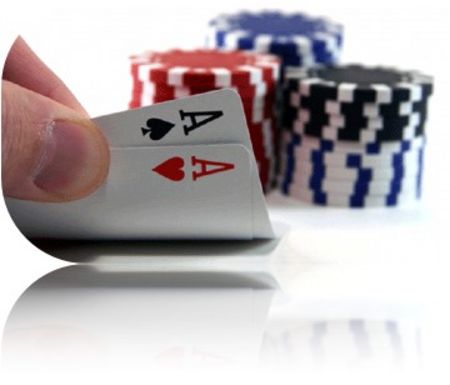Three-Suited

With a three-suited flop, you should generally only draw to the flush if you have one
of the top two remaining flush cards in your hand. For example, with a flop of A
♥ Q
♥
8
♥, you would need either the K
♥ or J
♥ to draw.
If the flop is 8
♥ 5
♥ 3
♥, you would
need either the A
♥ or K
♥. Remember, you will only hit your hand about 36% of the
time, so when you do, you want to be confident that you have a winning hand.
Drawing to the J
♥ or T
♥ is a losing play most of the time.
Normally it is difficult to get multi-way action with these types of flops. Against
several opponents, you could already be against a flush, so you should normally
just check and call. Raising in late position to try for a free card is risky, as many
opponents with a good hand will protect their hand. They will either reraise the flop
or call and bet out on the turn if another suited card does not come, With at least
three callers on the flop, you could raise since you are getting good odds on the
play.
When there are only one or two opponents and you have the nut flush draw, you
can often play the hand aggressively as a semi-bluff by either betting out or raising.
You are hoping that your opponents will fold, but if they call, you still have a strong
draw with many outs.
When you have additional possibilities that add value to your draw, you might play a
little more aggressively. For example, if you raise preflop with AA or KK and flop a
flush draw and overpair with a three-suited flop, you should usually bet out. If
someone bets into you, you can either raise or call. Calling can be a good play here
since you have a high pair and are not worried about overcards or opponents on
flush draws. You are either losing on the flop or have the best hand with little worry
about being beat by the turn or river card.
The following is a hand I played at The Poker Club that shows the potential benefit
of just calling against weak opponents. A middle player called preflop and I raised
on the button with A ♥ A ♣. Both blinds called.
Four players saw the flop of J ♥ 7 ♥ 4 ♥.
An aggressive weak player in the small blind bet out and the middle player called. I
debated between raising and calling but decided to call as I felt that the small blind
might already have a flush
The turn was the 6 ♥. The small blind bet and the middle player raised. I decided to
just call and the small blind reraised (remember this is an aggressive weak player).
The middle player and I called. The small blind bet out the river and the middle
player called. I raised and got called by both. The small blind had the Q ♥ 5 ♥ and
the middle player had the K ♥. If I had raised the flop, I would have greatly reduced
the action I received on later streets.
I show this example for two reasons. First, although I had a strong hand, I was still
beaten on the flop. You always need to be concerned about flopped flushes when
someone leads into a large field. Second, notice how playing contrary to what is
"normal" can lead you to win a large pot.
Advanced Concept: Deception is a key part of strategy for advanced players. You create deception
by playing contrary to what your opponents expect. When used in the right situations, deception can
sometimes result in gaining several additional bets that you would not have won otherwise.
Review
Flush draws are strong hands, as they are only 2 to 1 against improving by the
river. These odds are improved further when you add other elements to your hand
such as straight draws, overcards, or a pair.
You can usually draw to flushes with a two-suited flop with these few exceptions:
-
You are heads up in a small pot and don't have a pair, and you are confident
that your opponent has a pair higher than your two cards.
- There is a pair on the flop and a decent chance an opponent holds trips:
however, you can still draw sometimes depending on the action and size of
the pot.
- The action is so strong on the flop that your small flush draw could be
drawing dead to a higher flush draw.
With a three-suited flop, you should generally only draw to the flush if you have one
of the top two remaining flush cards in your hand.
When playing flush draws against three or more opponents, usually choose a
strategy that will keep as many players in the hand as possible. If several players
have already called, consider raising, especially when you are in late position.
Against one or two opponents, you can bet out or raise as a semi-bluff if you feel
there is a decent chance you can win the pot outright.
Whenever you have other elements to your hand such as straight draws, overcards,
or a pair, you can play your hand more aggressively than otherwise.
NEXT...Straight Draws

